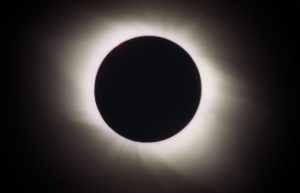By Eric Gentry
Solar glasses typically need to meet two constraints: You need something which will block most of the light, and you need something that can provide structural support, so it won’t fall apart while you’re staring at the sun. Thanks to modern chemistry, most of the ‘solar eclipse glasses’ you find use a specialized plastic polymer – it’s cheap, durable and relatively easy to make.
An alternative approach is to make glass lenses, which also have some darkening material mixed in with the glass. Similar idea, but typically more expensive, just as glass sunglasses are usually more expensive than plastic sunglasses for related reasons.
Other approaches have included adding a darkening material as a surface coating, such as Mylar. The Perkins Observatory considers Mylar, which is essentially an aluminum foil laminated to thin plastic sheets, as unsuitable. Similar materials have been used as solar telescope filters, but because surface coatings are just that – only on the surface – they are also typically more fragile. You must worry about small scratches, or pinholes. If most of your eye is safe, but one part is getting fried … then one part is still getting fried.
Which brings us to the next consideration.
What are solar glasses doing?
You’re not supposed to look directly at the sun because it’s bright and can cause damage to your eyes. It’s so bright, that seeing just 0.0032% of its light is at the upper limit of the “safe, but maybe uncomfortable range” – see Sky &Telescope. So, you need to block a lot of the light … and you need to do it in all wavelengths which can cause damage to your eyes.
 So, what about polarization filtering lenses? A single polarizing lenses can block about 50 percent of the incoming light (well, slightly more, since the sun’s light is partially polarized after passing through Earth’s atmosphere). But for every polarization filter you add, you only ever can block out another 50 percent of the light (due to the strangeness of quantum mechanics). A single filter gets you down to 50 percent, adding a second filter gets you to 25 percent, and so on. At that rate, you’d need about 15 perfectly polarizing filters in a row.
So, what about polarization filtering lenses? A single polarizing lenses can block about 50 percent of the incoming light (well, slightly more, since the sun’s light is partially polarized after passing through Earth’s atmosphere). But for every polarization filter you add, you only ever can block out another 50 percent of the light (due to the strangeness of quantum mechanics). A single filter gets you down to 50 percent, adding a second filter gets you to 25 percent, and so on. At that rate, you’d need about 15 perfectly polarizing filters in a row.
Solar eclipse glasses and simple solar telescope filters deliver a mix of all visible wavelengths of solar light, or “white light.” Much more interesting is the chance to see narrow bands of color. Most of the interesting effects happen at narrower wavelength bands, such as the H-alpha wavelength.
But this talk about different wavelengths is a reminder that, just because a material is blocking at one wavelength, doesn’t mean it’s blocking every wavelength. And there is a wide range of wavelengths that can damage our eyes.
We see visible light, but UV + IR (ultraviolet + infrared) light can also damage your eyes, even if you can’t see in those ranges. That’s why you need special materials for blocking sunlight — you can’t just hold something in front of the Sun and think you’ll be okay as long as it looks dark.
For instance, exposed color film might block enough visible light, but it won’t block enough IR light to be safe. For other materials, maybe it’s too much UV light. And these types of light can be nasty — your blink reflex only responds to visible light, so if you only block the visible light, you’ll have removed your body’s natural protection while still leaving the damaging rays.
So, only use solar glasses and telescope filters marked specifically for use as such.
 Eric Gentry is an applied scientist for Amazon. Formally an astronomer, he received his PhD from UC Santa Cruz, studying the intersection of computation and physics.
Eric Gentry is an applied scientist for Amazon. Formally an astronomer, he received his PhD from UC Santa Cruz, studying the intersection of computation and physics.

 The Sun is more active than it’s been in years. And if you want to know your equipment options from solar glasses to the most out of this world solar viewing and imaging options, check out our free publication – The Definitive Guide to Viewing and Imaging the Sun – simply click here and enjoy reading!
The Sun is more active than it’s been in years. And if you want to know your equipment options from solar glasses to the most out of this world solar viewing and imaging options, check out our free publication – The Definitive Guide to Viewing and Imaging the Sun – simply click here and enjoy reading!
And to make it easier for you to get the most extensive news, articles and reviews that are only available in the magazine pages of Astronomy Technology Today, we are offering a 1-year magazine subscription for only $6! Or, for an even better deal, we are offering 2 years for only $9. Click here to get these deals which only will be available for a very limited time. You can also check out a free sample issue here.

